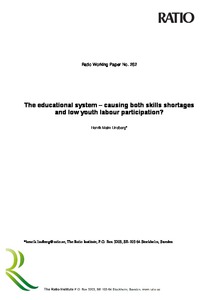The educational system – causing both skills shortages and low youth labour participation?
"The educational system is perhaps the most important feature for labour market entry. During the last decades huge investments have been made at different levels in this system, the Knowledge lift and a doubling of the number of students in tertiary education are examples, but what are the eff...
| Main Author: | |
|---|---|
| Institution: | ETUI-European Trade Union Institute |
| Format: | TEXT |
| Language: | English |
| Published: |
Stockholm
2015
The Ratio Institute |
| Subjects: | |
| Online Access: | https://www.labourline.org/KENTIKA-19113319124919315919-The-educational-system---causi.htm |
| Summary: | "The educational system is perhaps the most important feature for labour market entry. During the last decades huge investments have been made at different levels in this system, the Knowledge lift and a doubling of the number of students in tertiary education are examples, but what are the effects of these investments? The age of labour market entry has risen dramatically since the 1990s and in particular among those without fulfilled secondary schooling. In the paper I analyse the educational system in Sweden, mainly from secondary sources, in three dimensions – in terms of quality, efficiency and relevance. These are seen as essential in order to deliver both competence to businesses and to give young people opportunities in the labour market. Because of deficiencies in all three dimensions: foremost lack of quality at primary and secondary level, which is visible at PISA-tests, lack of efficiency at secondary and tertiary level that is visible when we measure examination frequency and graduation age, and lastly lack of relevance which is mostly notable in the vocational training." |
|---|---|
| Physical Description: | 30 p. Digital |

